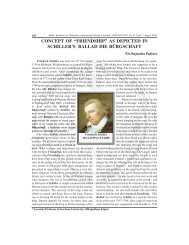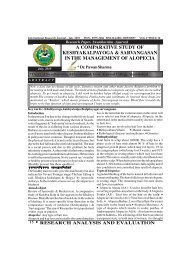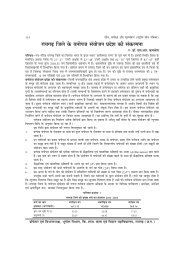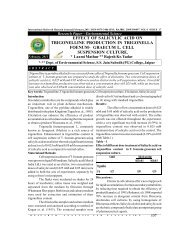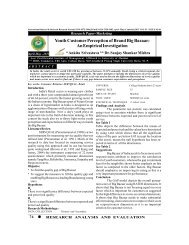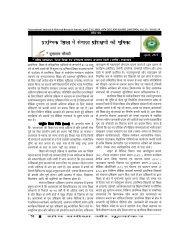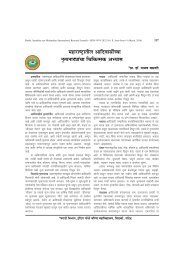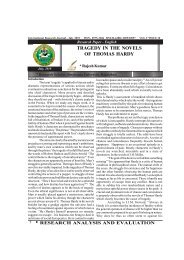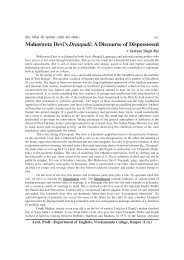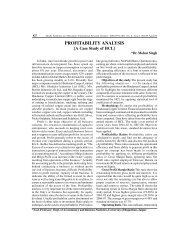Post Modernism, Cultural Heterogeneity and Differences in The ...
Post Modernism, Cultural Heterogeneity and Differences in The ...
Post Modernism, Cultural Heterogeneity and Differences in The ...
Create successful ePaper yourself
Turn your PDF publications into a flip-book with our unique Google optimized e-Paper software.
International Indexed & Referred Research Journal, October,2012. ISSN 0974-2832, RNI- RAJBIL 2009/29954; VoL. IV * ISSUE- 45<br />
Research Paper - English<br />
<strong>Post</strong> <strong>Modernism</strong>, <strong>Cultural</strong> <strong>Heterogeneity</strong> <strong>and</strong><br />
<strong>Differences</strong> <strong>in</strong> <strong>The</strong> Selected Works of Toni Morrison<br />
<strong>and</strong> Alice Walker<br />
* Seemant<br />
* Ph.D. , Scholar S<strong>in</strong>ghania University, Pacheri Bari-, Jhunjhunu (Raj.)<br />
Fem<strong>in</strong>ism, as a phenomenon of history, has two dist<strong>in</strong>ct<br />
phases. <strong>The</strong> first phase covers the period from 1830-<br />
1920 <strong>and</strong> the second from 1960 to present times. <strong>The</strong><br />
first phase fem<strong>in</strong>ism has its roots <strong>in</strong> classical liberal<br />
thought. It is def<strong>in</strong>ed by an emphasis on campaigns for<br />
women's enfranchisement <strong>and</strong> the extension of civil<br />
rights to women. <strong>The</strong> period, follow<strong>in</strong>g the achievement<br />
of vot<strong>in</strong>g rights for women <strong>in</strong> 1920, is regarded as<br />
a period of relative <strong>in</strong>action for fem<strong>in</strong>ism. <strong>The</strong> 1960s,<br />
however, witnessed the growth of widespread facilities<br />
of education for women, entry of women <strong>in</strong>to previously<br />
all male professions, the establishment of legislation<br />
on abortion <strong>and</strong> equal pay <strong>and</strong> the wide availability<br />
of birth control devices. <strong>The</strong>se developments created<br />
conditions conducive to the resurfac<strong>in</strong>g of fem<strong>in</strong>ism<br />
dur<strong>in</strong>g the 1960s which is regarded as the great<br />
watershed of late modernity.<br />
<strong>The</strong> study considers the three female protagonists,<br />
situated <strong>in</strong> a specific cultural <strong>and</strong> economic<br />
context, as paradigms of fem<strong>in</strong>ist analysis. For <strong>in</strong>stance,<br />
Pecola <strong>in</strong> <strong>The</strong> Bluest Eye <strong>in</strong>ternalizes the western/white<br />
st<strong>and</strong>ards of beauty under the racial pressure of the<br />
dom<strong>in</strong>ant culture. <strong>The</strong> colonization of m<strong>in</strong>d fosters her<br />
fatal fasc<strong>in</strong>ation for a pair of blue eyes. Her pray<strong>in</strong>g for<br />
the symbols of Anglo-Saxon beauty represents a<br />
doomed attempt on her part to live up to an aesthetic<br />
code that is essentially different from the concept of<br />
traditional black beauty. With<strong>in</strong> the black community<br />
itself, she is violated by her father, rejected by her<br />
mother, taunted by the black boys, mistreated by<br />
Gerald<strong>in</strong>e <strong>and</strong> betrayed by Junior. In the <strong>in</strong>tra-racial<br />
context, signify<strong>in</strong>g class hierarchy, she is humiliated<br />
by Maureen <strong>and</strong> defrauded by Soaphead Church.<br />
Similarly Sethe <strong>in</strong> Beloved <strong>and</strong> Celie <strong>in</strong> <strong>The</strong><br />
Color Purple are trapped <strong>in</strong> the <strong>in</strong>extricable web of<br />
gender, race <strong>and</strong> class which re<strong>in</strong>force one another <strong>in</strong><br />
block<strong>in</strong>g the black women's quest for identity which is<br />
regarded as a conceptual category. <strong>The</strong>y imp<strong>in</strong>ge relentlessly<br />
on the socio-political, psychosexual, cultural<br />
<strong>and</strong> economic aspects of the life practices of black<br />
women <strong>in</strong> America.<br />
<strong>The</strong> central question taken up <strong>in</strong> the fem<strong>in</strong>ist<br />
analysis of the selected works of Toni Morrison <strong>and</strong><br />
Alice Walker encompasses the notions of heterogene-<br />
SHODH, SAMIKSHA AUR MULYANKAN<br />
October ,2012<br />
ity, fragmentation, <strong>in</strong>determ<strong>in</strong>acy <strong>and</strong> differences, represented<br />
by the blacks' m<strong>in</strong>ority ethnic group. In the<br />
process the modernist notions of high culture patriarchy,<br />
elitism <strong>and</strong> homogeneity are supplanted by the<br />
black aesthetic <strong>in</strong> general <strong>and</strong> black women's radical<br />
traditions <strong>in</strong> particular.<br />
Black women writ<strong>in</strong>g touched a high watermark<br />
when Toni Morrison had the dist<strong>in</strong>ction of be<strong>in</strong>g<br />
the first black woman to receive the Nobel Prize for<br />
literature <strong>in</strong> 1993. Her evocative use of the colloquial <strong>in</strong><br />
<strong>The</strong> Bluest Eye <strong>and</strong> Beloved furnish an illustration of<br />
how she discards the l<strong>in</strong>guistic stratagems <strong>and</strong> subterfuges<br />
to capture the black female reality <strong>in</strong> all its bleakness.<br />
Toni Morrison's first novel <strong>The</strong> Bluest Eye (1970)<br />
makes a scath<strong>in</strong>g attack on the imposition of white/<br />
Anglo-Saxon st<strong>and</strong>ards of beauty on black women <strong>and</strong><br />
the creation of cultural perversion. It presents a critique<br />
of the dom<strong>in</strong>ant aesthetic that is <strong>in</strong>ternalized by<br />
majority of the black community, <strong>and</strong> attempts to<br />
deconstruct the meta-ethnicity, which exercises a hegemonic<br />
control over the lives of blacks <strong>in</strong> America.<br />
Toni Morrison's Beloved (1988) grows out of<br />
the historical context of American slavery <strong>and</strong> reconstruction.<br />
It embodies a response to the Fugitive Slave<br />
Law to which Sethe, the chief female protagonist of the<br />
novel, falls a prey <strong>in</strong> 1855. <strong>The</strong> fugitive slaves were<br />
those who had run away from slave masters <strong>in</strong> the<br />
south <strong>and</strong> found haven <strong>in</strong> the northern <strong>and</strong> border<br />
states. <strong>The</strong> Fugitive Slave law, enacted by the Congress,<br />
empowered the slave masters to reclaim their<br />
property i.e. the runaways.<br />
Sethe, a runaway slave, who is the chief female<br />
protagonist <strong>in</strong> Beloved slits her baby's throat<br />
rather than see her sold as a slave when her slave<br />
master comes to reclaim her <strong>and</strong> her children. Sethe is<br />
the fictional representation of Margaret Garner, who, <strong>in</strong><br />
1851, had escaped with her children from her master <strong>in</strong><br />
Kentucky to Ohio. When she <strong>and</strong> her children were<br />
about to be reclaimed by the slave master, she tried to<br />
kill her children rather than return them to a life of<br />
slavery. She succeeded <strong>in</strong> kill<strong>in</strong>g one of the children<br />
<strong>and</strong> was imprisoned for <strong>in</strong>fanticide. In address<strong>in</strong>g the<br />
issue of slavery, Morrison wants people to be able to<br />
feel at a personal level what it meant to be a slave <strong>and</strong><br />
15
International Indexed & Referred Research Journal, October,2012. ISSN 0974-2832, RNI- RAJBIL 2009/29954; VoL. IV * ISSUE- 45<br />
what slavery did to a people. Oprah W<strong>in</strong>frey po<strong>in</strong>ts systems of dom<strong>in</strong>ation, devised by the white establishment,<br />
to have hegemony over the blacks <strong>in</strong> America.<br />
out: "People resented Sethe not because of what she<br />
did but because there was never a moment of regret. <strong>The</strong> black fem<strong>in</strong>ist perspective on the three texts reveals<br />
that black women are subjected to racial white<br />
She didn't crumble she didn't fail (20).<br />
<strong>The</strong> Color Purple unfolds the panorama of dom<strong>in</strong>ation as members of the black community. At the<br />
black female reality of the neo-slavery period that takes same time, they are maltreated with <strong>in</strong> the black community<br />
itself because of their gender. In this perspective,<br />
shape <strong>in</strong> the smithy of black male brutality towards<br />
black females, racial/patriarchal oppression <strong>and</strong> misogynist<br />
assumptions. <strong>The</strong> novel focuses on the pro-<br />
Sethe <strong>and</strong> Celie are taken as models of fem<strong>in</strong>istanalysis.<br />
the doubly trapped female protagonists i.e. Pecola,<br />
cess of the self-discovery of an unlettered black southern<br />
woman. It traces the gradual growth of her Eye, Beloved <strong>and</strong> <strong>The</strong> Color Purple theorizes power<br />
<strong>The</strong> black fem<strong>in</strong>ist analysis of the <strong>The</strong> Bluest<br />
radicalization <strong>and</strong> empowerment through female bond<strong>in</strong>g,<br />
education <strong>and</strong> self-employment. <strong>The</strong> black femi-<br />
shap<strong>in</strong>g of black subjectivity <strong>and</strong> identity dur<strong>in</strong>g sla-<br />
relations between the whites <strong>and</strong> the blacks <strong>and</strong> the<br />
nist analysis reveals how black female radicalism, embrac<strong>in</strong>g<br />
of womanhood, exploration of black heritage tive of colonial <strong>and</strong> neo-colonial politics, the fem<strong>in</strong>ist<br />
very <strong>and</strong> the neo slavery period. In the overall perspec-<br />
<strong>and</strong> resultant self-determ<strong>in</strong>ation br<strong>in</strong>g to fruition Celie's analysis unmasks the power structures that eng<strong>in</strong>eer<br />
quest for identity <strong>and</strong> history.<br />
racial oppression <strong>and</strong> cultural perversion. It<br />
Celie succeeds <strong>in</strong> her quest for identity <strong>and</strong> deconstructs whiteness <strong>and</strong> blackness with a view to<br />
history by develop<strong>in</strong>g an underst<strong>and</strong><strong>in</strong>g of her roots destabiliz<strong>in</strong>g the two as biological categories <strong>and</strong> project<strong>in</strong>g<br />
them as cultural constructs. <strong>The</strong> redef<strong>in</strong>ed per-<br />
<strong>and</strong> heritage <strong>and</strong> acquir<strong>in</strong>g the awareness that she has<br />
a right to happ<strong>in</strong>ess, passion, creativity <strong>and</strong> emotional spective on the mediat<strong>in</strong>g concepts reveals that personal<br />
is political, sexual is racial <strong>and</strong> the private is<br />
fulfilment. To exercise her rights as an <strong>in</strong>dividual, Celie<br />
learns to resist the advances of black men who h<strong>in</strong>der public <strong>in</strong> the fem<strong>in</strong>ist discourse on Pecola's <strong>and</strong> Sethe's<br />
her self-fulfilment.<br />
search for authentic existence <strong>in</strong> <strong>The</strong> Bluest Eye <strong>and</strong><br />
<strong>The</strong> fem<strong>in</strong>ist analysis of the selected works of Beloved <strong>and</strong> Celie's search for status, dignity <strong>and</strong> identity<br />
<strong>and</strong> history <strong>in</strong> <strong>The</strong> Color Purple.<br />
Toni Morrison <strong>and</strong> Alice Walker looks upon <strong>The</strong> Bluest<br />
Eye, Beloved <strong>and</strong> <strong>The</strong> Color Purple as a black radical<br />
response to aesthetic/cultural perversion, slavery <strong>and</strong><br />
black male cruelty respectively. It br<strong>in</strong>gs to light the<br />
R E F E R E N C E<br />
1 Morrison, Toni. Beloved. London: Picador, 1988.<br />
2 ---. <strong>The</strong> Bluest Eye. London: Picador, 1993.<br />
3 Walker, Alice. <strong>The</strong> Color Purple. New York: Wash<strong>in</strong>gton Square Press, 1982.<br />
4 W<strong>in</strong>frey, Oprah. Journey to Beloved. New York: Hyperion, 1998.<br />
16 ’kks/k leh{kk vkSj ewY;kadu



